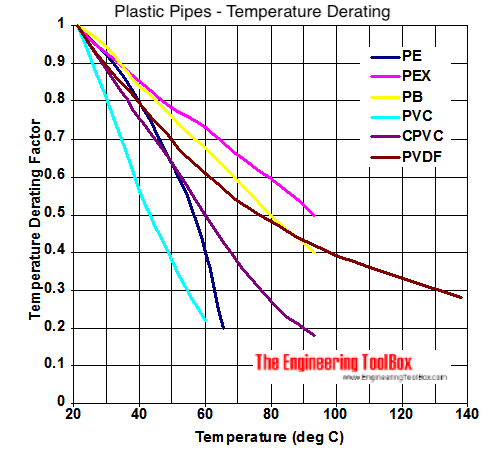Plastic Pipes - Maximum Operating Temperatures
Piping materials like ABS, PE, PVC, CPVC, PB, PP and SR and pressure and operating temperature limits.
Plastic Pipes Operating Temperatures
Typical maximum operating temperatures for common plastic pipe materials are indicated below. Note that working pressure varies with type of material and schedule (wall thickness).
| Plastic Pipe Material | Operating Temperature | |||
|---|---|---|---|---|
| With Pressure | Without Pressure | |||
| (oF) | (oC) | (oF) | oC) | |
| ABS - Acrylonitrilebutadiene Styrene | 100 | 38 | 180 | 82 |
| PE - Polyethylene | 100 | 38 | 180 | 82 |
| PVC - Polyvinylchloride | 100 | 38 | 140 | 60 |
| CPVC - Chlorinated Polyvinyl Chloride | 180 | 82 | 180 | 82 |
| PB - Polybutylene | 180 | 82 | 200 | 93 |
| PP - Polypropylene | 100 | 38 | 180 | 82 |
| SR - Styrene Rubber Plastic | 150 | 66 | ||
Maximum Short Time Operating Temperature
- for pipes without pressure.
- PVC : 95 oC
- PP : 100 oC
- PE : 95 oC
Heat Distortion Temperature
- is the temperature where a test piece of a material placed in a heat medium with a bending load (18.6 kg/cm2) applied - reaches a specified deflection.
- ABS: 104 - 106 oC
- PVC: 54 - 80 oC
- HDPE: 43 - 49 oC
- LDPE: 32 - 41 oC
- PP: 57 - 64 oC
Vicat Softening Temperature
- is the temperature where a needle shaped penetrator sinks into a test piece a specified depth when a specified vertical load (1 kg) is applied.
- ABS: 102.3 oC
- PVC: 92 oC
- PE: 127.3 oC
- PP: 152.2 oC




